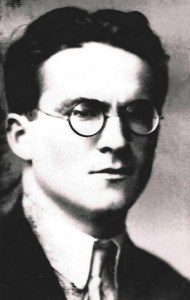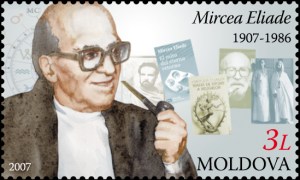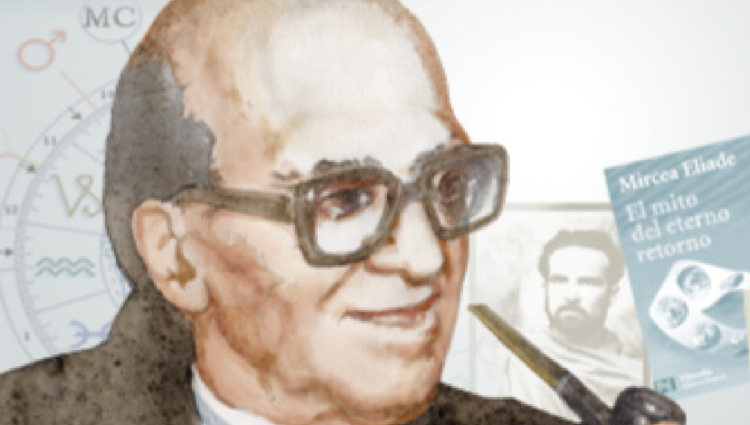Through his interpretive method, Mircea Eliade sought to keep open the path of metaphysics, and even mysticism, at a time when secular interpretations of culture—sociological, psychoanalytical, economical, and so forth—triumphantly dominated the scene of the human sciences.
 An erudite historian of religions and a passionate author of fiction well known in Romania, Mircea Eliade developed a well-articulated interpretation of literature, usually termed “mythological analysis” (or “mythanalysis”). This interpretive approach began as an attempt to answer some difficult questions and to account for the presence of a number of mythological symbols in the writings of certain authors—especially symbols of which they themselves were not fully aware. Such inquiries eventually led Mircea Eliade to understand the relationships between myths, symbols, and fiction as being connected in significant ways.
An erudite historian of religions and a passionate author of fiction well known in Romania, Mircea Eliade developed a well-articulated interpretation of literature, usually termed “mythological analysis” (or “mythanalysis”). This interpretive approach began as an attempt to answer some difficult questions and to account for the presence of a number of mythological symbols in the writings of certain authors—especially symbols of which they themselves were not fully aware. Such inquiries eventually led Mircea Eliade to understand the relationships between myths, symbols, and fiction as being connected in significant ways.
Convinced that man cannot survive without myths and legends, Eliade has often emphasized that “narrative prose, especially the novel, has taken, in modern societies, the place occupied by the recitation of myths and fairy tales in traditional and popular societies. Furthermore, the ‘mythic’ structure of certain modern novels can be discerned, demonstrating the literary survival of major mythological themes and characters.” Eliade also observes that, despite the vicissitudes and degradations suffered throughout history, myths remain present, usually involuntarily, in the deep structure of literary artistic creations.
To demonstrate this thesis, Eliade proposes interpretations consistent with his mythological hypothesis. For example, in his extensive, personal journal, the scholar suggests such an interpretation of a specific work belonging to Jules Verne:
“I am reading Jules Verne’s Voyage au Centre de la Terre, fascinated by the boldness of symbolism, the precision, and opulence of the images. A whole study could be written on the secret message of this book. The adventure is of initiatory nature: as in any initiation, there are the wanderings in the labyrinth, the descent into the underworld, the passage through the Waters, the trial by fire, encounters with monsters, the test of absolute solitude and darkness, and finally, the dizzying ascent, equivalent to the apotheosis of the initiate. But how accurate are the images of these underground worlds, of these realms beyond, —how precise and coherent is the mythology barely concealed under Jules Verne’s scientific jargon?”
Although he was urged by the theater critic Guy Dumur to write a comprehensive study on the imaginary universe of Verne, Eliade was unable to find the necessary time to compose such a book. However, he did perform a few interpretations from this perspective, which reveals the mythological substratum of literary works. These include two substantial essays, The Stairs of Julien Green and The Island of Euthanasius, published in 1939 in a journal edited by the Romanian Royal Foundations and later included, in reverse chronological order, in the volume bearing the title of the latter.
The stairs of Julien Green
Writing of Julien Green’s journal, Eliade acknowledged that the famous literary convert “is always captivating.” Excerpts from Green’s memoirs, included in Eliade’s own Journal, are accompanied by often admiring comments and observations, showing that the American-French novelist was one of his most beloved authors. To begin his analysis, Eliade isolates a certain biographical detail of Julien Green’s life to provide the foundation of his entire interpretation. It concerns a note from Green’s journal dated April 3, 1933:
“In all my books, the idea of fear or any other strong emotion seems inexplicably linked to a staircase. I noticed this yesterday, reviewing the novels I have written. For example, in Le Voyageur, the ascent of the old colonel corresponds in the spirit of the hero to a kind of progressive growth of fear. In Mont-Cinère, Emily encounters her father’s ghost on the stairs. In Adrienne Mesurat, she jumps on her father’s back on the stairs, where she spends part of the night. In Léviathan, M-me Grosgeorge, prey to a powerful anxiety, goes up and down the stairs. In Les chefs de la mort, the hero meditates on his crime on a staircase. In L’autre sommeil, the hero faints on a staircase. In Epaves, on a staircase, Phillippe wanders in his indecision and spies on his wife. Finally, in the story I am finishing now, a staircase is the scene of a sinister fit of mad laughter. I wonder how I could repeat this effect so often without noticing. When I was a child, I dreamed that I was being chased on a staircase. My mother experienced the same fears in her youth; maybe something has remained with me too. For many novelists, I am sure, the accumulation of immemorial memories is what makes them write. They speak for hundreds of dead, their dead; they express, finally, everything their ancestors have kept deep in their souls out of prudence or modesty.”
Eliade is fascinated by the persistence of certain images, such as that of the staircase (both in the waking and nocturnal states), which are often reiterated by Green in his novels. Following the writer’s suggestion, he notes that “this ‘motif’ of stairs (steps, ascent) belongs to those immemorial memories that lie in the soul of all people.” He then takes a most interesting direction in attempting to explain the obsessive recurrence of certain images in the consciousness of writers. In a theoretical writing from 1937, Cosmologie si alchimie babiloniana (Babylonian Cosmology and Alchemy), Eliade emphasized the “extraordinary frequency of steps and stairs in the beliefs of all peoples,” suggesting the existence of deep symbolic and metaphysical meanings of ascent.
Building on evidence from the history of religions, Eliade asserts that there is a justification for Green’s involuntary associations between fear, death, and the steps of the staircase; such a justification is necessarily based on a coherence in which the individual’s imagination or will plays no role. This beginning of his interpretation is interrupted to make way for a systematic critique of the psychoanalytic interpretations which were fashionable in his time. Then, Eliade returns to the symbolism of stairs to state that “the steps or the staircase represent, in all traditions, the path to absolute reality.”
To convince his readers of the validity of his mythological and symbolic interpretations, Eliade always draws on his rich erudition, extracting multiple examples from his files as a historian of religions. After exposing the ascensional symbolism encountered in Mesopotamians, Egyptians, Ugro-Finnic and Siberian peoples, and Indians, Eliade returns to Julien Green’s stairs to note that the discussed image finds its theoretical justification “in the purest and ecumenical symbolism.”
Dealing with the presence of certain symbols in Green’s works, Eliade knows that the major issue is the absence of any intention on the part of the author in this regard, raising the issue of whether an interpretation of a novel or a poem can have any value if it is based upon elements of which the author was not aware, and which were not deliberately included. The answer Eliade proposes doesn’t actually provide a solution, but merely points, perhaps, in the direction where it should be sought:
“The author’s ‘will’ or ‘culture’ doesn’t matter much when it comes to identifying a symbol or a metaphysical principle in a literary work. The symbol finds its way and illuminates in its own way the entire work, with or without the author’s intention … The question is whether these ‘immemorial memories’ are simply ‘dark’ legacies (as psychoanalysts believe) or have a noble origin; whether traditional symbolism originates in certain tropisms or lower automatisms or in a ‘metaphysics’ of perfect coherence and clarity.”
By suggesting the metaphysical origin of various symbols present in literary works such as Julien Green’s novels, Mircea Eliade opened a new path: that of mythological analysis, which was followed by some thinkers interested in the roots of literary creation. Emil Turdeanu, Nicolae Balotă, Eugen Todoran, Anton Dumitriu, and especially Ioan Petru Culianu pursued this direction, publishing essays and studies oriented in similar way.
However, the issue of this approach’s legitimacy will probably never be fully and satisfactorily resolved. The most significant weak point is the inability of the “method” to prove the direct continuity between the meanings of certain symbols or myths present in literary creations (more precisely, in the consciousness of their authors) and the meanings resulting from hermeneutic labor.
The lost paradise
Asserting the perpetuity of the great symbolic narratives, Eliade identifies those myths that have visibly survived in the modern literary imagination. It is important to note that, for him, the concept of “myth” does not imply anything derogatory, fictional, or deceitful. On the contrary, myths have a significance that involves both truth and reality. Of course, not all myths are the same. He often distinguishes ‘true myths’ from those affected by superstitions and the exalted imagination of false “spiritual masters.”
The first of the ‘true myths’ is that of the Terrestrial Paradise, omnipresent in almost all European literatures and well represented in Tolkien’s stories: “The Terrestrial Paradise, which Christopher Columbus still believed in (wasn’t he convinced he had discovered it?), became in the 19th century an oceanic island.” The example is not chosen randomly. The terrestrial paradise is one of the oldest themes in Eliade’s studies. The Island of Euthanasius, an essay published in 1939, extensively addresses this motif as it is present in both the poetry and prose of the main poet of Romanian culture, Mihai Eminescu (1850-1889).
In Eliade’s opinion, “the letter of the old hermit, with which Chapter III of Cezara begins, undoubtedly contains the most perfect paradisiacal vision in Romanian literature.” A substantial quote follows, describing the Edenic island, a quote that prompts the analysis that will reveal the persistence of certain archaic symbols. Before moving on to this stage, Eliade shows—using certain statements from the critic and historian G. Călinescu in favor of his interpretation—that the concrete sources used by Mihai Eminescu are not of great interest.
 The mythological analysis always marginalizes source research in favor of another type of investigation, grounded in the axiom of the existence of a metaphysical dimension that lends coherence to literary works. This is why Euthanasius’s island, the true core of Eminescu’s narrative, “participates in another geography; mythological, not physical.” The essay proceeds with comparisons to the happy islands of ancient Greece, as well as to other similar realms mentioned in Egyptian or Celtic sources, then continues by multiplying references from Eminescu’s work where islands and oceanic environments are frequent. Although acknowledging that the frequency of oceanic elements and the image of the Edenic island is specific to the Romantic movement, Eliade does not accept reducing the discussions to a simple problem related to the poet’s sources and influences. That is because he is always focused on emphasizing and revealing the metaphysical meanings encapsulated in the symbols used by the writer.
The mythological analysis always marginalizes source research in favor of another type of investigation, grounded in the axiom of the existence of a metaphysical dimension that lends coherence to literary works. This is why Euthanasius’s island, the true core of Eminescu’s narrative, “participates in another geography; mythological, not physical.” The essay proceeds with comparisons to the happy islands of ancient Greece, as well as to other similar realms mentioned in Egyptian or Celtic sources, then continues by multiplying references from Eminescu’s work where islands and oceanic environments are frequent. Although acknowledging that the frequency of oceanic elements and the image of the Edenic island is specific to the Romantic movement, Eliade does not accept reducing the discussions to a simple problem related to the poet’s sources and influences. That is because he is always focused on emphasizing and revealing the metaphysical meanings encapsulated in the symbols used by the writer.
To elucidate these meanings, Eliade turns to elements of Hindu mythology describing the manifestation of creation—symbolized by an island—in the context of the primordial chaos indicated by the aquatic element. This direction of his investigation was suggested to him by the fact that Eminescu, influenced by Schopenhauer, had read numerous ancient Indian mythological and philosophical texts. Yet, despite the coherence of Eliade’s interpretation, the question of the legitimacy of such interpretations remains open, at least from a strictly aesthetic perspective. In any case, Eliade is an advocate of the unconscious, involuntary presence in artistic images and symbols of mythological origin. His broader explanation, based on the notion of the “unconscious” correlated with that of intuition, reveals the existence of an extra- or supra-rational zone containing symbols used involuntarily by writers.
In practice, every writer or poet who uses certain symbols in their writings does so by “re-inventing” those symbols within the context of their own creation. J.R.R. Tolkien was right to speak of them, in comparison to the Demiurge—the supreme Creator—as being only “sub-creators.” Stemming from a true hidden treasure, symbols are simultaneously rediscovered and created by any author who, in this way, gives a certain metaphysical coherence to his story. Eliade believes that the presence of symbols is what simultaneously provides readers with both intellectual understanding and aesthetic joy. They are the results of an act of contemplation that, through immersion in the universe proposed by the author, increasingly deepens.
According to the myth-analytical way of understanding literary creations, it does not matter whether the poet or the writer knows or is conscious of the meanings of the symbols he uses in his creations. All these images and motifs have “descended” into the pages of novels and poems we read from the distant horizon of myths and sacred stories, through faculties of the human spirit situated beyond discursive and analytical reasoning. Through such an interpretive “method”, Eliade sought to keep open the path of metaphysics (and even mysticism) at a time when secular interpretations of culture—sociological, psychoanalytical, economical, and so forth—triumphantly dominated the scene of the human sciences. Whether or not he succeeded is a subject for long-term debate that will require substantial further discussion.
The Imaginative Conservative applies the principle of appreciation to the discussion of culture and politics—we approach dialogue with magnanimity rather than with mere civility. Will you help us remain a refreshing oasis in the increasingly contentious arena of modern discourse? Please consider donating now.
The featured image is an image of Mircea Eliade on a stamp of Moldova, courtesy of Wikimedia Commons. The top image is a photograph of Mircea Eliade and is in the public domain, courtesy of Wikimedia Commons.


